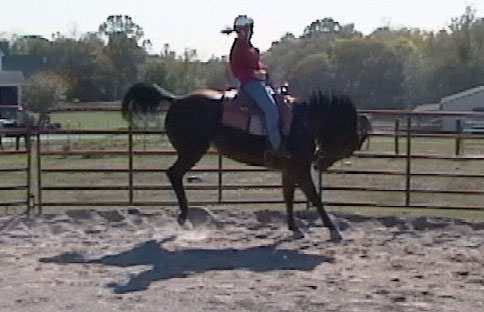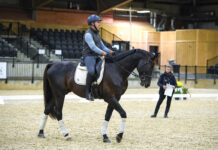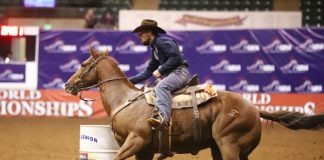If you ride, one day you will find yourself on a horse that bucks. It’s a natural defense a horse uses to launch a predator from his back. Bucking can be an expression of youthful exuberance, abundant or nervous energy, or pain. A horse may also react to an environmental stimulus by bucking. Biting horseflies and stinging bees are notorious for sending horses into bucking fits. Conflict between horse and rider is another reason a horse may fling his hindquarters into the air.
When a horse bucks he drops his nose between his knees, stiffens his forelegs, and kicks upward with his hind feet. How difficult it is to ride depends on how hard a horse bucks, how long he bucks, and the skill of the rider. If you find yourself on a horse that’s bucking, here’s what you need to do:
- Relax:
Easier said than done, but panicking shuts down your cognitive processes. That means you’ve stopped thinking and you’re not helping your horse. Breathe, speak quietly to your horse, and focus on the ride. Keep your legs long and your heels down to lower your center of gravity and increase the likelihood of staying on. Tightly gripping with your legs (or spurs!) will increase your horse’s energy and throw off your balance. Sit deep on your pockets and soften your lower back, allowing your hips to fluidly follow your horse’s movements. - Flex your horse’s head
When a horse bucks he braces his body and stiffens his forelegs. Flexing his head is the first step to regaining control. Ride with both hands on the reins. Shorten one rein until you can see the side of your horse’s face. Turn your horse’s head by making the rein short instead of pulling backward which can throw off your balance and his. Pulling on both reins equally will give your horse’s something to brace against and encourage him to keep bucking. - Move your horse’s shoulders
Ask your horse to step to the inside of a sharp turn. Lead his head into the turn by lifting and opening your inside rein (the inside rein is the rein toward which your horse is flexed). This rebalances your horse. Th e less weight he has on his forehand, the more weight he has on his hindquarters, and the more likely his back feet will stay on the ground.
e less weight he has on his forehand, the more weight he has on his hindquarters, and the more likely his back feet will stay on the ground. - Send your horse forward
A horse propels himself with his hindquarters, but a bucking horse lacks forward momentum. Flex your horse’s head with a shortened inside rein. Hold the rein in the “open” position away from his neck to mobilize his shoulders. Then drive him forward with rhythmic leg pressure on both sides of his body. - Use a pulley rein
Shorten both reins. Hold one taut (not tight) and you brace your hand against your horse’s neck or the saddle horn. Lift the other rein up and back and sit deep in the saddle. Use pulses of pressure to encourage your horse to shift his weight back and lift his head. This is an emergency technique can be hard on the horse. It should be used with caution and only when all else fails. Once you have your horse’s head up, follow steps 1-4. It’s also perfectly sensible to dismount if it feels uncomfortable or unsafe to continue the ride.
Liked this article? Here’s more on handling bad behavior:
Handling Bad Behavior
How to Stop Your Horse from Bucking after a Jump
When Horses Act Dangerously
Dale Rudin is a CHA-certified riding instructor and clinician with a mindful and balanced approach to horsemanship and riding.
www.un-naturalhorsemanship.com







great tips.
Easier said than done! Especially if you are riding a tall, athletic horse whose intention is test you. Oh yeah, there’s no horn on a dressage saddle.
Yes, Novice! I was violently bucked off into a wall almost 2 weeks ago. A 17.2 Thoroughbred gelding who is plenty healthy (and a dressage saddle as well). I’ve ridden out bucking horses several times in the past, and I was sticking on this one, except that he went to the wall and turned to the left. OMG. Great advice here, but not sure it would have helped. Nonetheless, good tips.
Ya know, this may be all and good for a trainer, but when you are actually in the mist of a bucking, you aren’t going to remember to do all these things you just said. I am really sure about that as I have trained many young horses. You just have to remember the one thing you mentioned.. Turn the horses head.
What do you do if your horse bucks and you do NOT have a saddle on? Besides falling on my butt in the cold snow. lol
Not everyone rides Western. I ride with a hunter/jump saddle so there is no ‘horn’ to push on.
Where’s your helmet?
Where the head goes the body will follow. Tip the nose disengage front end drive forward. I hate a horse that bucks but they are out there everywhere
I hope I can remember all of these great tips. I will remember “Tom’s” tip. Where the head goes the body will follow.
Not so easier when your horse is a bucking bronco. And sometimes it’s safer to bail. The two worst injuries I’ve had are from bucking horses and from staying on too long. You can be injured even if you’re still on the horse. Get off if you’re out of control and/or if you’re bareback.
First of all..where is your helmet? You have offered some good ideas such as: relax, stop gripping tightly with your legs and being careful if you are wearing spurs – I once learned that lesson as my one horse was into his 10th buck with no end in sight until I removed the spurs which were dug into his sides & stopped gripping for dear life (to stay on) and gave intermittent upward jabs on the reins to bring his head upwards until he ended his outburst.
You spoke often of bending but it really comes down to – what is your horse doing beneath you? Would it be of greater interest to address: what are the different types of buck a horse might take, i.e. what is the horse actually doing with their body while bucking and then discuss courses of action. I had 1 horse who used to buck upwards & then flip her hips sideways – always interesting to try to stay with; I landed everywhere on her neck, just about between her ears,1/2 off her side, etc, etc you name it I landed there (but never fell off), bending her would never have been and option. Another ‘sweet’ fellow of mine an athletic thoroughbred off the track, would take huge leaps forward (you essentially just had to keep your seat aligned with him and pull his head up – to which he would get over his outbursts and we would continue our ride as if nothing had ever happened). My now 30 year old Connemara -Thb X, in his younger years would leap upwards like a rabbit (it was said he once went 10 feet in the air while I was launched another 5′) and my present big guy, a Holsteiner (17h2 and as athletic as all) who lets face it, I’m not going to win with under ANY circumstance when he throws a tizzy fit..I dismount post haste!
I personally think having a horn in front of me would be a hindrance if not dangerous of being smashed into my gut, but this discussion is not about riding styles. From my past experience bringing a horses head up has been the number 1 key to getting the horse out of a buck (as well as having mentioned to not stiffen or grip so tightly you add to frenzy). And one thing you didn’t mention is, if it isn’t a bee sting, exuberance, etc. is there any causes you might discover as to why the horse is bucking such as ill fitting tack, medical reason, etc., etc. Lastly, I would have liked to hear address ‘staying safe’! No one needs to prove anything to anyone – if you feel you need to bail out..do it. Better safe than the alternative!
Well, the last post from Bobbi makes a lot of sense, but so does all the other posts. staying safe is definitely the ultimate goal.
My 16.3 black and white paint mare, who hadn’t bucked in the past, did. The first bucking wasn’t a big deal. I brushed myself off and got back on. In hindsight, I should have checked her tack by taking her saddle off and repositioning it after re-brushing her back, and checked the flank cinch before remounting her. The result was bucking me off again and fracturing my wrist. Since she had not bucked before, I wasn’t prepared for it. Her bucking was immediate. Oh, I also free lunged her in the round pen ahead of time all tacked up, but she was not responding well, and didn’t want to move out.
I should have known better.
Advice is always appreciated.
Thank You,
Dan